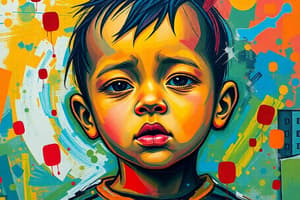Podcast
Questions and Answers
Which of the following symptoms is NOT associated with post-traumatic stress disorder (PTSD) in young children?
Which of the following symptoms is NOT associated with post-traumatic stress disorder (PTSD) in young children?
- Hypervigilance
- Exaggerated startle response
- Intense physical aggression
- Heightened sense of calmness (correct)
What may be a long-term consequence of exposure to trauma in children?
What may be a long-term consequence of exposure to trauma in children?
- Improved emotional regulation
- Enhanced social interactions
- Diminished interest in previously enjoyed activities (correct)
- Increased resilience to stress
Which symptom can indicate a child is experiencing intrusive memories related to a trauma?
Which symptom can indicate a child is experiencing intrusive memories related to a trauma?
- Distressing dreams about the event (correct)
- Increased sociability
- Frequent joyful play
- Improved sleep patterns
What behavior might indicate a child's heightened arousal and reactivity due to PTSD?
What behavior might indicate a child's heightened arousal and reactivity due to PTSD?
What is an example of persistent avoidance in a child dealing with PTSD?
What is an example of persistent avoidance in a child dealing with PTSD?
Which cognitive alteration might a child with PTSD experience?
Which cognitive alteration might a child with PTSD experience?
What duration of symptom disturbance is required for a diagnosis of PTSD in children?
What duration of symptom disturbance is required for a diagnosis of PTSD in children?
Which of these is an example of a dissociative symptom that may occur in PTSD?
Which of these is an example of a dissociative symptom that may occur in PTSD?
Which of the following is a symptom of Post-Traumatic Stress Disorder (PTSD) in children?
Which of the following is a symptom of Post-Traumatic Stress Disorder (PTSD) in children?
What characterizes a child with acute stress disorder after exposure to trauma?
What characterizes a child with acute stress disorder after exposure to trauma?
How does an unusual response to common stress differ from stress-related disorders?
How does an unusual response to common stress differ from stress-related disorders?
Which of the following indicates the severity of a child's disorder?
Which of the following indicates the severity of a child's disorder?
What are dissociative reactions in children experiencing PTSD?
What are dissociative reactions in children experiencing PTSD?
Which criterion must be met to diagnose a child with a trauma- and stress-related disorder?
Which criterion must be met to diagnose a child with a trauma- and stress-related disorder?
What negative mood symptom may indicate PTSD in children?
What negative mood symptom may indicate PTSD in children?
How can the trauma experienced by a child lead to long-term consequences?
How can the trauma experienced by a child lead to long-term consequences?
What is a common symptom of PTSD in children related to their play activities?
What is a common symptom of PTSD in children related to their play activities?
Which of the following is a negative alteration in mood associated with PTSD?
Which of the following is a negative alteration in mood associated with PTSD?
Which symptom best describes dissociative reactions in PTSD?
Which symptom best describes dissociative reactions in PTSD?
What type of trauma can lead to negative alterations in one’s belief system?
What type of trauma can lead to negative alterations in one’s belief system?
What best describes the persistent avoidance symptom in PTSD?
What best describes the persistent avoidance symptom in PTSD?
How can negative alterations in cognition manifest in individuals with PTSD?
How can negative alterations in cognition manifest in individuals with PTSD?
What kind of dreams are commonly reported by young children with PTSD?
What kind of dreams are commonly reported by young children with PTSD?
Which symptom is indicative of PTSD in young children?
Which symptom is indicative of PTSD in young children?
What type of reactions do children commonly exhibit after experiencing trauma?
What type of reactions do children commonly exhibit after experiencing trauma?
Which group is identified as being more at risk for sexual abuse?
Which group is identified as being more at risk for sexual abuse?
How does victimization rate generally relate to a child's age?
How does victimization rate generally relate to a child's age?
In terms of racial characteristics, which group has the highest rates of victimization?
In terms of racial characteristics, which group has the highest rates of victimization?
Which factor is crucial for understanding physical abuse and neglect in children?
Which factor is crucial for understanding physical abuse and neglect in children?
What is a contributing element to the integrated model of physical child abuse?
What is a contributing element to the integrated model of physical child abuse?
Which of the following reflects typical dissociative symptoms in children affected by trauma?
Which of the following reflects typical dissociative symptoms in children affected by trauma?
Which statement about the long-term consequences of child abuse is true?
Which statement about the long-term consequences of child abuse is true?
What symptom is NOT included in the dissociative subtype of PTSD?
What symptom is NOT included in the dissociative subtype of PTSD?
What risk factor is heightened in teens with a history of maltreatment?
What risk factor is heightened in teens with a history of maltreatment?
Which of the following is a common mood disturbance observed in children with a history of abuse?
Which of the following is a common mood disturbance observed in children with a history of abuse?
What long-term consequence might result from childhood sexual abuse?
What long-term consequence might result from childhood sexual abuse?
What do children with a history of abuse typically develop towards themselves and others?
What do children with a history of abuse typically develop towards themselves and others?
Which neurobiological alterations are observed in individuals with a history of child abuse?
Which neurobiological alterations are observed in individuals with a history of child abuse?
What is a treatment intervention that can be used for children affected by trauma?
What is a treatment intervention that can be used for children affected by trauma?
What could contribute to delayed expression of PTSD symptoms in a child?
What could contribute to delayed expression of PTSD symptoms in a child?
Flashcards are hidden until you start studying
Study Notes
Post-Traumatic Stress Disorder in Children
- Delayed expression of PTSD occurs if diagnostic criteria are not met until 6 months after a trauma, with possible immediate symptoms.
- Children 6 years and younger can experience PTSD through direct exposure, witnessing events, or learning about trauma to caregivers.
- Symptoms include distressing memories, nightmares, trauma-specific play, and intense distress from reminders of the event.
- Persistent avoidance of reminders, alterations in cognition and mood, irritability, and angry outbursts are common in young children with PTSD.
Symptoms and Duration of PTSD
- Key PTSD symptoms: verbal aggression, hypervigilance, startle response, concentration issues, and sleep disturbances.
- Symptoms must persist for over a month and significantly impair relationships or functioning; cannot be solely due to substances or medical conditions.
- The dissociative subtype involves depersonalization and derealization not attributed to substance effects.
Long-term Effects of PTSD
- PTSD can become chronic, with remissions and relapses, potentially lasting a lifetime.
- Associated mood disturbances include depression, emotional distress, and suicidal thoughts, particularly in abused children.
- Teens with a history of maltreatment are at higher risk for substance abuse, while childhood sexual abuse may lead to eating disorders.
Causes and Effects of Child Abuse
- Sexual abuse can lead to traumatic sexualization, affecting emotional and behavioral development.
- Maltreated infants exhibit poor emotion regulation, leading to insecure attachment and difficulty with caregiver interactions.
- Children develop negative self-views and world perspectives due to lack of healthy guidance from parents.
- Neurobiological changes in the hypothalamic–pituitary–adrenal axis and norepinephrine systems are noted in those with a history of abuse.
Intervention Challenges
- Barriers to intervention include reluctance to seek help and fear of legal repercussions such as losing custody.
- Exposure-based therapy and psychological first aid are effective interventions for children post-trauma.
Other Stress Disorders in Children
- Acute Stress Disorder is characterized by symptoms similar to PTSD occurring within 1 month after a traumatic event, requiring at least nine symptoms across various categories (intrusion, avoidance, etc.).
- Adjustment Disorders may apply when children react unusually to less severe stressors.
Trauma Exposure Criteria
- Defined criteria for traumatic exposure include direct experience, witnessing events, and learning about traumatic incidents involving close relations.
Physiological and Psychological Reactions
- Children may display recurrent distressing memories or play reenacting trauma themes; they may express distress at cues related to trauma.
- Symptoms include negative beliefs about oneself and others, persistent emotional states, and diminished interest in activities.
Victimization and Abuse Trends
- Exploitation, including commercial and sexual exploitation, is a significant trauma for children and adolescents worldwide.
- Younger children are at higher risk for overall abuse, with sexual abuse predominating in those over 12 years old.
- Victimization rates are inversely related to age in non-sexual abuse cases; 80% of sexual abuse victims are female, with maltreatment affecting both genders similarly.
Racial and Discrimination Factors
- Majority of maltreated victims are white (44%), with significant proportions being African-American (22%) or Hispanic (21%).
- Highest victimization rates are observed among African-American, American Indian, and multi-racial children, followed by white, Hispanic, and Asian children.
Integrated Model of Physical Child Abuse
- Integrated model includes habits of aggression and patterns of physical punishment, with destabilizing factors affecting dynamics of abuse.
- Relational disorders and stress factors play crucial roles in physical abuse, whereas sexual abuse is often a premeditated act.
Studying That Suits You
Use AI to generate personalized quizzes and flashcards to suit your learning preferences.




